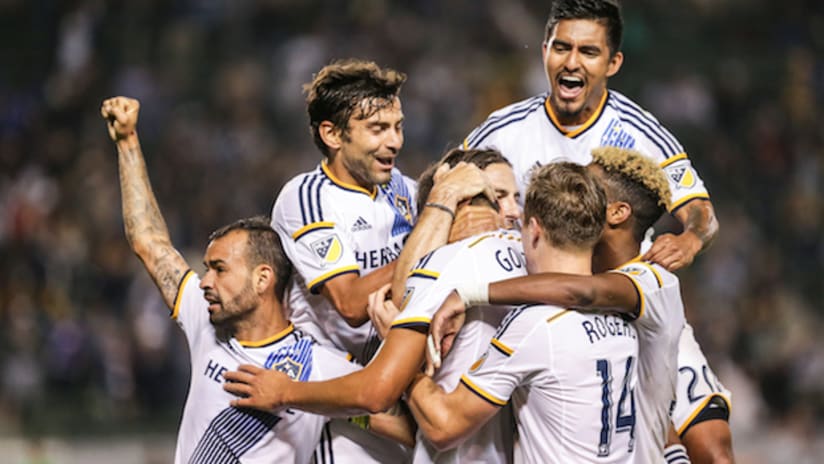When boxing legend Joe Frazier died two weeks ago, I – like a lot of sports fans – found myself going through old fight footage on YouTube. Somehow I ended up sitting down and watching all seven rounds of Muhammad Ali’s first win over Sonny Liston to take the heavyweight title in 1964.
And what stuck out was that quick Ali jab. Liston wanted to brawl, but Ali wouldn’t have it; he just kept flicking out that left hand, pushing Liston back, bloodying him and, eventually, winning the fight.
Liston never got through that jab. He never got close.
On Sunday night, the Houston Dynamo were Sonny Liston.
The most common tactical storyline heading into Sunday’s Cup was, “LA’s counterattack vs. Houston’s set-piece dominance,” and the underlying implication being that Houston wanted to turn the game into a brawl. I bought into it myself, predicting a 2-1 Dynamo win – “How,” I asked on Twitter, “can this LA team possibly stop Houston on set pieces? Even without Brad Davis, they’ll get two goals.”
Forget the two goals: Houston never even got the two dangerous set pieces. LA just kept pushing them back, farther and farther, with that quick jab.
What I forgot is that the Galaxy were and are so, so much more than just a team that sits rigidly and waits for chances to hit on the break. They won three different playoff games in three different styles heading into Sunday, then put on a clinic to make it four in four.
Pinning Cameron back
The key to Houston’s late-season surge was switching Geoff Cameron to central defense. His combination of athleticism and skill is pretty much unmatched in MLS, and changed the Dynamo from a side almost totally reliant upon Davis to generate chances to one that could build steadily from the back and exploit gaps.
WATCH: Full MLS Cup highlights

It’s safe to say that LA got their scouting report right. The Opta Chalkboard from Sunday shows Cameron with more than twice as many defensive interventions in his own third than he had against Sporting. The Galaxy’s plan was to attack left back Jermaine Taylor with overlaps from Sean Franklin while Landon Donovan cut inside, and it forced Cameron to put out fire after fire.
Instead of winning balls higher and more centrally – and thus, primed for immediate distribution to the central midfield – Cameron was reduced primarily to simply clearing his area in a series of emergency actions.
Crucially, LA also kept their own defensive line very high, not giving Houston the types of counterattack opportunities they had converted into the second goal against Sporting. That forced the Dynamo into either playing over the top – a tactic that Omar Gonzalez was only too happy to deal with – or with small combinations through the middle. That latter one was always going to be a reach without the services of Davis.
Breaking the central midfield
Cameron being pushed that deep had a cascade effect on the Houston central midfield pairing of Luiz Camargo and Adam Moffat. They never got on the ball in combination play, never got a handle on the tempo, and never much bothered LA’s build-up.
That was in part because of the Galaxy’s spacing on the night. David Beckham always sits deep, and the Chalkboard shows he was even deeper against Houston than normal. Perhaps that was because of his hamstring injury, but whatever the reason, it almost entirely neutralized Camargo.
The Brazilian spent the first quarter of the game looking almost like he was man-marking Beckham, and ended up following him deeper and deeper into LA’s end. In theory it works, but the reality is that by pushing that far up the field, Camargo left his defenders with one fewer outlet option.
And so he rarely saw the ball. Against Sporting, he had 93 total touches; against LA, just 42.
Beckham, meanwhile, got on the ball at will. And because he was so much deeper than expected, he often had time to pick his spots when distributing. It didn’t lead to a goal, but it was the story of how LA prevented the game from turning into a brawl. That was the Galaxy’s left jab.
The goal itself
When Bruce Arena pushed Donovan from right midfield up to forward with just more than a half-hour left, it was a calculated risk. The benefit was getting the best finisher in the history of the MLS Cup Playoffs closer to goal; the cost was playing wider through the midfield and mostly ending the ruthless attack on Taylor.
The move obviously paid off. Houston came back into the game a little bit, and Moffat ended up producing their best chance off a cross from Corey Ashe, but the Galaxy were willing to make that trade, and were always dangerous despite slightly more rigid spacing.
The upshot is that LA were able to isolate Donovan and Robbie Keane – who probably should have been Man of the Match – on Bobby Boswell and Cameron, who was, by that point, struggling badly with a Grade 1 sprain of his right MCL. Boswell trying to stay with Keane in space is a mismatch, and once Donovan sorted out his runs, it was just a matter of time until one of the two found enough room for the winner.
The greatest?
After Saturday’s training session, both Donovan and Arena said the message the Galaxy sent all season was that they could win with whatever style, whatever tactics they needed on the day. Twenty-four hours later, they went out and – once again – proved as much.
Is it enough to label them the best side in MLS history? Arena’s old D.C. United sides – particularly the 1997 bunch that were a missed penalty by Raul Diaz Arce from winning the MLS Cup/Supporters’ Shield/US Open Cup treble – and Sigi Schmid’s 2008 double-winning Columbus Crew are certainly still in the argument.
But it’s hard to ignore just how flexible and just how good this Galaxy bunch have been this year. Especially on Sunday.
Matthew Doyle writes the Armchair Analyst column for MLSsoccer.com.




